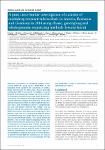A joint cross-border investigation of a cluster of multidrug-resistant tuberculosis in Austria, Romania and Germany in 2014 using classic, genotyping and whole genome sequencing methods: lessons learnt
Fiebig, Lena
Kohl, Thomas A.
Popovici, O.
Mühlenfeld, M.
Indra, A.
Homorodean, D.
Chiotan, D.
Richter, E.
Rüsch-Gerdes, Sabine
Schmidgruber, B.
Beckert, P.
Hauer, Barbara
Niemann, Stefan
Allerberger, Franz
Haas, Walter
Molecular surveillance of multidrug-resistant tuberculosis (MDR-TB) using 24-loci MIRU-VNTR in the European Union suggests the occurrence of international transmission. In early 2014, Austria detected a molecular MDR-TB cluster of five isolates. Links to Romania and Germany prompted the three countries to investigate possible cross-border MDR-TB transmission jointly. We searched genotyping databases, genotyped additional isolates from Romania, used whole genome sequencing (WGS) to infer putative transmission links, and investigated pairwise epidemiological links and patient mobility. Ten isolates from 10 patients shared the same 24-loci MIRU-VNTR pattern. Within this cluster, WGS defined two subgroups of four patients each. The first comprised an MDR-TB patient from Romania who had sought medical care in Austria and two patients from Austria. The second comprised patients, two of them epidemiologically linked, who lived in three different countries but had the same city of provenance in Romania. Our findings strongly suggested that the two cases in Austrian citizens resulted from a newly introduced MDR-TB strain, followed by domestic transmission. For the other cases, transmission probably occurred in the same city of provenance. To prevent further MDR-TB transmission, we need to ensure universal access to early and adequate therapy and collaborate closely in tuberculosis care beyond administrative borders.
Dateien zu dieser Publikation
Keine Lizenzangabe

